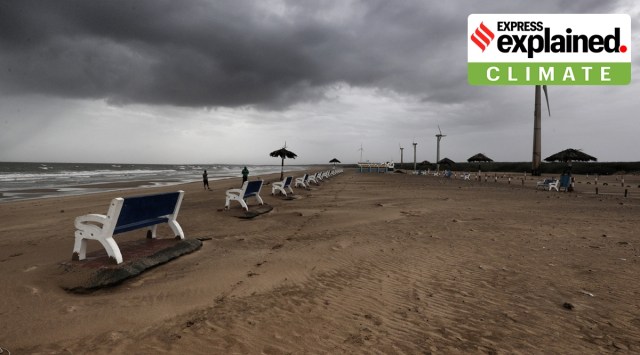Cyclones no longer a threat as they were in the ’90s, early 2000s
Death toll, even in the most powerful cyclones, has come down to double digits, at worst.
 Mandvi beach in Kutch district Wednesday. Cyclone Biparjoy is set to make landfall near Jakhau Port in Kutch district on Thursday evening, IMD said. (Express photo by Nirmal Harindran)
Mandvi beach in Kutch district Wednesday. Cyclone Biparjoy is set to make landfall near Jakhau Port in Kutch district on Thursday evening, IMD said. (Express photo by Nirmal Harindran)
For a country that gets hit by cyclones fairly regularly, at least two to three times a year, it is not surprising that India has put in place standard operating procedures to deal with these. Cyclones are no longer as big a threat as they were till the 1990s or even early 2000s.
It was the devastation caused by the 1998 super cyclone in Odisha — unofficial estimates of death toll range anywhere between 10,000 and 30,000 — that turned out to be a wake-up call and forced the government to develop a comprehensive plan to deal with cyclones. In the last one decade, the damage caused by cyclones, especially in terms of human lives, has been reduced significantly. Death toll, even in the most powerful cyclones, has come down to double digits, at worst.
Over the years, India has developed a three-layered response mechanism for cyclones. The first layer deals with the software — an early warning system, creation of awareness among local populations, evacuation plans and drills, training and dissemination of information. The second layer involves building the hardware — creation of shelters where people and cattle can be shifted, setting up of weather instruments and warning centres for better forecasts, and construction of embankments, connecting roads and bridges. The last layer is about making coastal infrastructure resilient to cyclones. This would require taking critical infrastructure like power transmission lines or water supply lines underground, ensuring that railway networks and airports do not get inundated and continue to function, and health systems do not get disrupted.
A significant amount of work has been accomplished on the first two layers of this response system, as a result of which cyclones are forecast accurately days in advance, and the loss of lives has reduced tremendously. The third part is still a work in progress.
- 01
- 02
- 03
- 04
- 05






































